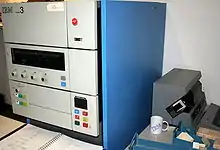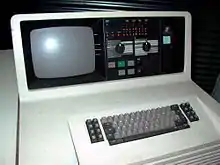Midrange computer
Midrange computers, or midrange systems, are a class of computer systems which fall in between mainframe computers and microcomputers.[1]

This class of machine emerged in the 1960s, with models from Digital Equipment Corporation (PDP line), Data General (NOVA), Hewlett-Packard (HP3000) widely used in science and research as well as for business - and referred to as minicomputers.[2]
IBM favored the term "midrange computer" for their comparable, but more business-oriented, systems.[3]

IBM Midrange Systems
- System/3 was the first of the IBM midrange systems (1969)[4]
- System/32 (introduced in 1975) [5] was a 16-bit single-user system also known as the IBM 5320.
- System/34 (1977) was intended as successor to both the 3 and the 32.
- System/38 (1979) was the first Midrange system to have an integrated relational database management system (DBMS). The 38 had 48-bit addressing.
- System/36 (1983) had two 16-bit processors with an operating system that supported multiprogramming.
- AS/400 was introduced under that name in 1988, renamed eServer iSeries in 2000, and subsequently became IBM System i in 2006.
- IBM System i was subsequently replaced by the IBM Power Systems in April 2008.

Positioning
Since the 1990s, when the client–server model of computing became predominant, computers of the comparable class are instead usually known as servers[6] to recognize that they usually "serve" end users at their "client" computers.
Midrange systems are primarily high-end network servers and other types of servers that can handle the large-scale processing of many business applications. Although not as powerful as mainframe computers, they are less costly to buy, operate, and maintain than mainframe systems and thus meet the computing needs of many organizations. Midrange systems have become popular as powerful network servers[7] to help manage large Internet Web sites, corporate intranets and extranets, and other networks. Today, midrange systems include servers used in industrial process-control and manufacturing plants and play major roles in computer-aided manufacturing (CAM). They can also take the form of powerful technical workstations for computer-aided design (CAD) and other computation and graphics-intensive applications. Midrange system are also used as front-end servers to assist mainframe computers in telecommunications processing and network management.
References
- Estabrooks, Maurice (1995). Electronic technology, corporate strategy, and world transformation. Westport, Conn.: Quorum Books. p. 53. ISBN 0899309690.
- Bell, Gordon (9 January 2015). "Rise and Fall of Minicomputers". Engineering and Technology History Wiki. Archived from the original on 5 April 2017. Retrieved 28 January 2017.
- "1969 IBM System/3 promotional ad - midrange, minicomputer, Computer History, RPG". Computer History Archives Project. Netherlands.
- "IBM System/3 announcement" (PDF).
- "IBM System/32". IBM Corporation.
- "now referred to as small or midsize servers." "Minicomputer". Britannica.com.
- "PC Magazine, Definition of: midrange computer".
